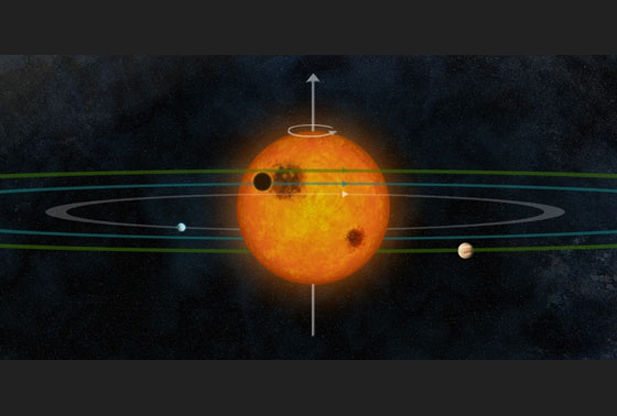We’ve found a lot of strange exo-planets in the last two decades, hot Jupiter’s spiraling into their star like giant comets and super earths that could be covered in exotic oceans and ices hundreds of miles deep. Before it’s all over, Kepler may end up being the most famous name in all the Milky Way galaxy! Now the plucky telescope by the same name has found an alien system that looks a little more familiar in one key respect:
Red Orbit — The study shows the trio of planets orbiting the star within one degree, relative to each other, and relative to the star’s equator, showing a sense of geometry in its alignment.
“In our solar system, the trajectory of the planets is parallel to the rotation of the sun, which shows they probably formed from a spinning disc,” Roberto Sanchis-Ojeda, a physics graduate student at MIT who led the research, said. “In this system, we show that the same thing happens.”
Kepler 30 is a main sequence yellow-white star similar in size and development to our sun. At least two of the planets are likely to be gas giants roughly the size and mass of Jupiter or Saturn. But we won’t be visiting this familiar arrangement anytime soon: it’s about 10,000 light-years away from ours.


Only 10k LY? A mere hop, skip, and a reeeeeeeeeeeeaaaaaaaaaaaaally long jump away. :)
Damn, but I do hope we’re somehow wrong about that aspect of physics. I’d love to see the human race someday find a way to explore systems like that. (Although I worry that as a species, we won’t have matured enough to not exploit inhabited worlds….)
I just got done watching the entire run of Enterprise, which while it had it’s flaws, it was quite unlike every other Star Trek series in that it was extremely consistent from episode to episode with the science and the details. One part that particularly pleased me was their dedication to consistency with the speeds that they would travel at.
Warp speed, in Star Trek, works very much like the old Richter scale, in that each whole number was ten times faster than the previous whole number. Warp 1 is the speed of light, Warp 2 is ten times the speed of light, Warp 3 is a hundred times the speed of light, Warp 3.1 is two hundred times the speed of light, etc. So when a character would say ‘It’s three light years away’, I could calculate in my head how long it would take to travel there (3 years at warp 1, 3.6 months at warp 2, 11 days at warp 3, a little over a day at warp 4, and 2.6 hours at Warp 5. So when the navigator says they’ll get there in 10 hours, you know they are traveling at warp 4.6 or thereabouts.
I guess really the point I’m getting at is when I read this, I realized that even at Warp 5 (10,000 times the speed of light and the top speed for the Enterprise) it would still take an entire year to travel to this system.
And the Enterprise D could zip there in less than an hour at warp 9. Picard had it easy – in some episodes he got that thing up to warp 9.95, which is 1800 light years a second!
/hugenerd
^According to the internet, Voyager could sustain warp 9.975 out of the box (before they added all the slipstream stuff).
If they needed to travel just 70,000 light years and could go 1800+ light years per second, what exactly was the problem again?
Hmmm…
Okay, looks like I was completely wrong. Enterprise wasn’t any more consistent than any of the other series.
I found this:
http://en.memory-alpha.org/wiki/Warp_factor
Which is basically just a big list of how inconsistent it all was.
Oh well.
Stardates are also a confusing mess.
The theory behind their variation is like why GPS satellites are run slow by a factor of 4.5*10^(-10) — relativistic effects. But it’s rather easy to estimate them for our Galaxy, at least with a simple model of dark-matter density ~ 1/r^2 (r = distance from center). It makes constant circular-orbit velocity, which in fact we observe. The observed time at r = r2 relative to r = r1 is fast by about (5*10^(-7))*ln(r2/r1). For 1 kiloparsec inward or outward, this is 7*10^(-8). That’s about 2 seconds over 1 year.
What I always wondered is, how do they communicate in ‘real-time’ with individuals thousands of light years away while traveling at faster-than-light speeds? Special Relativity suggests that establishing a common frame of reference should be somewhere between impossible and even more impossible.
I’m wondering which ground-based telescope they’ll use to cross reference. (Kepler measures the reduction in light from the star as the planets eclipses it. Earth-based telescopes measure the tiny change in red-shift of the star as it’s pulled slightly off-centre by the orbiting planet(s).) I’m really hoping they’ll use the TNG and the HARPS-N spectrograph because – holy FSM! – my husband helped to install it.